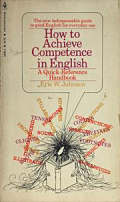

| Book of the Month | ||
 |
How to Achieve Competence in English |  |
Publisher: Bantam
Author: Eric W. Johnson
$5.00
ISBN: 978-0553134933
This book's title and purpose do not really agree. The book is not really a guide to achieving competence, but rather a handbook of handy information about using English. There are no exercises and certainly no organized course of study to take a student along the road to competence. Rather this book should be used as a language-learning tool, in the same way as a dictionary or a thesaurus.
The author has around 25 years of experience in teaching English, and he has packed this experience into a pocket-sized book of notes on everything from 'abbreviations' to 'writing for whom'. The A-W choice of topics is deliberate, as the book organizes its topics alphabetically. Indeed there is a large letter at the top of each page to let you know where you are in the alphabet.(Even more convenient would be a list of topics, or at least an appendix, since - for example - 'writing for whom' could also be listed under 'a' for 'audience' and 'r' for 'readers'.)
As the book is composed, it's impossible to tell what the topics are, or exactly where to find them, or even how many topics there are. (Some letters like 'p' are densely populated with 'punctuations', 'paragraphs' and 'plagiarism'; others like 'j' and 'k' are empty, but included, while 'x', 'y' and 'z' together make up the very last page of the book.)
Almost all of the 190 pages in the book are content, apart from a very short introduction explaining the ideas behind the book and how to use it. Expect to spend a while jumping around the contents as - due to the weakness in properly locating topics - the author has had to guess where readers end up. So under 'h' 'helper verbs' refer the user to 'verbs' and 'hyperbole' tells you to go to 'figurative language'. One useful convention is that if a word is spelled with full capitalization this means that it has its own entry (somewhere) in the book.
Discussion of each topic varies from a few lines - e.g. 'Exclamation points' to articles several pages long, such as the one on 'essays'. Some of the most useful topics are not about competence in English at all - for example the section on 'Libraries' has a concise and handy guide to the Dewey Decimal System of filing books.
After each letter of the alphabet there is a space with lines drawn where the user can add his own notes. This includes spaces with the letters where the author himself couldn't think of anything to say. Each letter begins with a humorous line drawing that is vaguely related to the letter in question ('t' has a person in a tub, and beneath this is listed 'Table of contents' which shows that the author has heard of such, even if he does not use one himself.)
Who is this book for? Certainly it is not for someone striving to learn competence in English. However, it is ideal for the working student who wants to know how to organize an essay without plagiarizing his sources, prepare for an exam, find a book on the library shelves and then get guidance on how to organize paragraphs and check common spelling errors. The book does all that and more. In other words this is a handbook for a moderately competent English user who needs help at times.
Verdict: Would be more useful with better content organization
Assessment 7/10